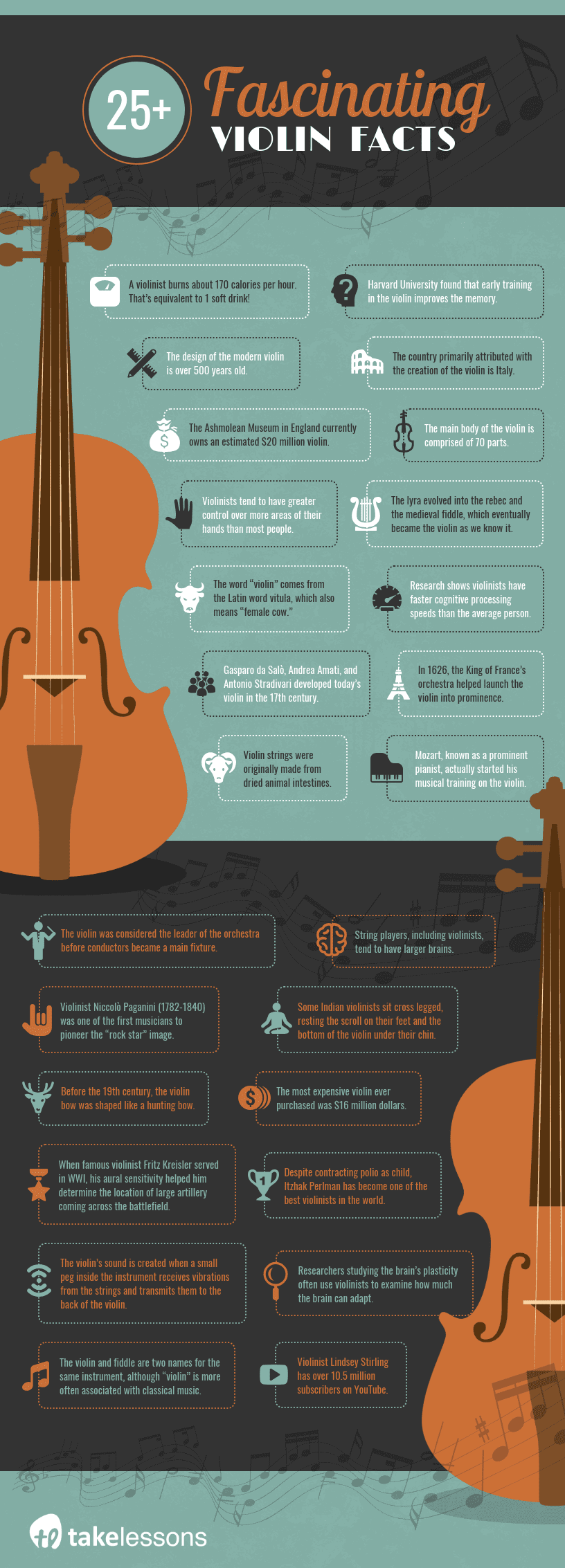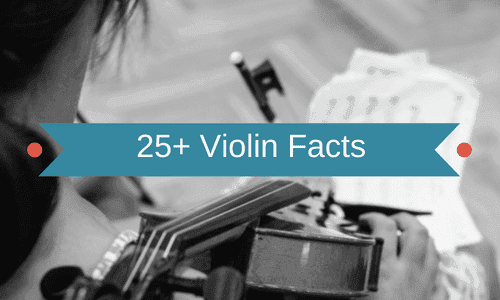
Looking for fun violin facts? Here, you’ll find the 25 most interesting facts about the violin we could round up!
People have spent their entire lives studying the possible benefits of playing the violin, its history, and how it functions. Enjoy exploring some of their findings in this short list of violin facts.
25 Interesting Violin Facts

(This infographic was made by our friends at Venngage).
Interesting Facts About the Violin – In Detail
- Most people consider playing the violin an intellectual pursuit. However, a violinist can burn around 170 calories per hour. That’s equivalent to about one soft drink!
- Based on research measuring the different levels of cognitive processing, violinists have shown to develop faster processing speeds compared to the average person who does not play an instrument.
- Even though the exact year the violin was officially created is a mystery, we do know that the design of the modern violin is over 500 years old. While the violin hasn’t changed much over that time, the bow and other accessories have gone through many changes.
- Italy is primarily attributed with the creation of the modern violin. A lot of Italian makers, such as Stradivari, lived and worked in the small town of Cremona, creating some of the world’s oldest and most valuable violins.
- The word “violin” comes from the medieval Latin word vitula. What makes this one of the funniest violin facts is that oddly enough, the modern Latin translation of vitula also means “female cow.”
- String players, like violinists, tend to have larger brains. This is due in part to the complex motor skills and reasoning required to play the instrument.
- The main body of the modern violin contains 70 different parts. In high quality instruments, these parts are all made from a variety of woods.
- Famous violinist Fritz Kreisler served in WWI as a captain. His aural sensitivity, developed by playing the violin, allowed him to determine the location of large artillery by listening to the changing pitch of incoming shells across the battlefield.
- The violin was the leader of the orchestra before conductors became a main fixture. Prominent composers would often conduct their orchestral arrangements from the first violin chair or the concertmaster position.
- Even though Mozart was a prominent pianist and composer, he also played the violin. In fact, Mozart’s father began his son’s musical training on the violin.
- The modern violin was developed largely by Gasparo da Salò, Andrea Amati, and Antonio Stradivari, all of which lived in Italy during the 17th century.
- The violin has ancestral ties to the Byzantine empire through its distant cousin, the lyra. This archaic instrument evolved into the “rebec” and then the medieval fiddle, before finally transforming into the modern violin.
- The violin has become an essential instrument in cultures all over the world, from Ireland to India. Some of these cultures have developed different ways of playing the instrument. One of the most interesting violin facts is that some Indian players sit cross-legged while playing, and rest the scroll on their feet with the bottom of the violin under their chin!
- The parts of the brain that are responsible for the left and right hand are more sensitive in violinists. This means that violinists have greater conscious control over more areas of their hands.
- Some of the most popular careers for violinists include teaching, and performing in orchestras or other small groups. Highly sought after orchestral positions are extremely difficult to obtain.
- In 1626, King Louis XIII of France created an orchestra, Les 24 Violons du Roi. This helped launch the violin into prominence for the first time in history.
- Violinist Niccolò Paganini was one of the first musicians to pioneer the “rock star” image. His revolutionary compositional style and playing inspired many other performers and composers such as Liszt, Schumann, Brahms, and Rachmaninoff.
- Many violin facts show that playing the instrument has a significant impact on the mind. A study from Harvard University found that early training in the violin improves a myriad of cognitive skills including memory, nonverbal reasoning, and attention.
- The rich sound of the violin partially comes from a small dowel inside the instrument beneath the bridge, called the “sound post.” It does this by receiving the vibrations, created by the strings, from the bridge and transmitting them to the back of the violin.
These are just a few of the most interesting facts about the violin, but there are so many other wonderful things to learn. If any of these violin facts sparked your interest, or if you’ve always wanted to play the violin, check out the spectacular teachers at TakeLessons.
The violin is one of the most challenging and rewarding instruments you can learn. It is also one of the few instruments capable of matching the diversity and complexity of the human voice. Know any more interesting facts about the violin? Leave a comment below!
 Post Author: Nicole R. Nicole has been teaching violin since 2011 in Colorado. She has a BA in Music from the University of Denver, with certificates in the Suzuki and Alexander techniques. Learn more about Nicole here!
Post Author: Nicole R. Nicole has been teaching violin since 2011 in Colorado. She has a BA in Music from the University of Denver, with certificates in the Suzuki and Alexander techniques. Learn more about Nicole here!Sources:
- Elber, T., Pantev, C, Wienbruch, C., et al. (1995). “Increased cortical representation of the fingers of the left hand in string players.” Science 270, 305-309
- “Lira.” Edited by The Editors of Encyclopaedia Britannica, Encyclopædia Britannica, Encyclopædia Britannica, Inc., 30 June 2017, www.britannica.com/art/lira-musical-instrument
- “Violin.” Edited by The Editors of Encyclopaedia Britannica, Encyclopædia Britannica, Encyclopædia Britannica, Inc., 23 Mar. 2018, www.britannica.com/art/violin
- “Music Improves Brain Functio.” Written by Phillip F. Shewe, Live Science, Purch, 29 Mar. 2018, https://www.livescience.com/7950-music-improves-brain-function.html
- Halfpenny, Eric, and Theodore C. Grame. “Stringed Instrument.” Encyclopædia Britannica, Encyclopædia Britannica, Inc., 9 Feb. 2018, www.britannica.com/art/stringed-instrument/The-violin-family
- “New Study Finds Playing Violin Sheds the Calories of 2 Glasses of Wine per Hour.” The World’s Leading Classical Music News Source. Est 2009., 10 Jan. 2014, theviolinchannel.com/new-study-finds-violin-practice-sheds-around-2-glasses-wine-hour
- Lewis, Charlton T, et al. “Vitula.” Vitula – Wiktionary, Wikipedia, 26 May 2017, 16:31, en.wiktionary.org/wiki/vitula
- KREISLER, FRITZ. FOUR WEEKS IN THE TRENCHES: the War Story of a Violinist (Wwi Centenary Series). LAST POST PRESS, 2014
- Sadie, Stanley. “Wolfgang Amadeus Mozart.” Encyclopædia Britannica, Encyclopædia Britannica, Inc., 12 Jan. 2018, www.britannica.com/biography/Wolfgang-Amadeus-Mozart
- Britannica, The Editors of Encyclopaedia. “Viol.” Encyclopædia Britannica, Encyclopædia Britannica, Inc., 5 Dec. 2016, www.britannica.com/art/viol
- Britannica, The Editors of Encyclopaedia. “Niccolò Paganini.” Encyclopædia Britannica, Encyclopædia Britannica, Inc., 24 Feb. 2017, www.britannica.com/biography/Niccolo-Paganini
- “These Are The 12 Most Expensive Violins Of All Time.” CMUSE, 6 Sept. 2017, www.cmuse.org/12-most-expensive-violins/
Jessica Dais
